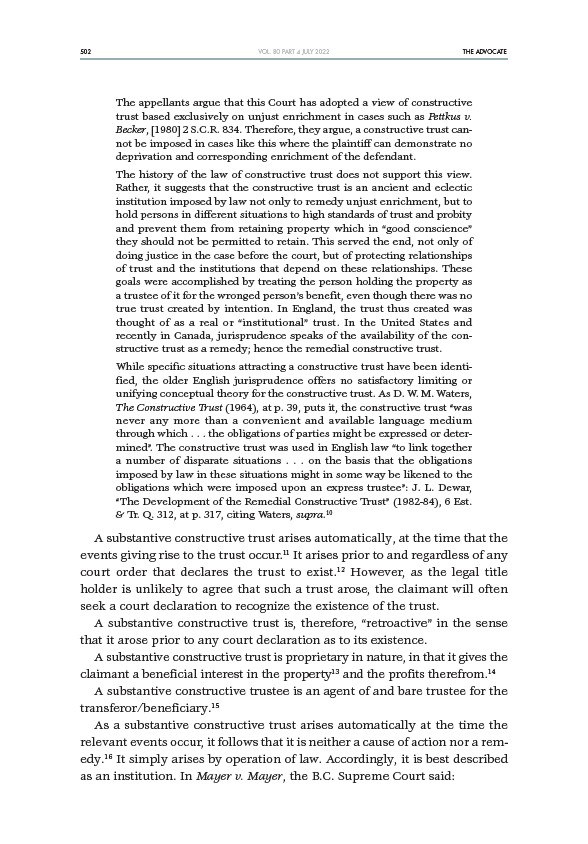
502 THE ADVOCATE
VOL. 80 PART 4 JULY 2022
The appellants argue that this Court has adopted a view of constructive
trust based exclusively on unjust enrichment in cases such as Pettkus v.
Becker, 1980 2 S.C.R. 834. Therefore, they argue, a constructive trust cannot
be imposed in cases like this where the plaintiff can demonstrate no
deprivation and corresponding enrichment of the defendant.
The history of the law of constructive trust does not support this view.
Rather, it suggests that the constructive trust is an ancient and eclectic
institution imposed by law not only to remedy unjust enrichment, but to
hold persons in different situations to high standards of trust and probity
and prevent them from retaining property which in “good conscience”
they should not be permitted to retain. This served the end, not only of
doing justice in the case before the court, but of protecting relationships
of trust and the institutions that depend on these relationships. These
goals were accomplished by treating the person holding the property as
a trustee of it for the wronged person’s benefit, even though there was no
true trust created by intention. In England, the trust thus created was
thought of as a real or “institutional” trust. In the United States and
recently in Canada, jurisprudence speaks of the availability of the constructive
trust as a remedy; hence the remedial constructive trust.
While specific situations attracting a constructive trust have been identified,
the older English jurisprudence offers no satisfactory limiting or
unifying conceptual theory for the constructive trust. As D. W. M. Waters,
The Constructive Trust (1964), at p. 39, puts it, the constructive trust “was
never any more than a convenient and available language medium
through which . . . the obligations of parties might be expressed or determined”.
The constructive trust was used in English law “to link together
a number of disparate situations . . . on the basis that the obligations
imposed by law in these situations might in some way be likened to the
obligations which were imposed upon an express trustee”: J. L. Dewar,
“The Development of the Remedial Constructive Trust” (1982-84), 6 Est.
& Tr. Q. 312, at p. 317, citing Waters, supra.10
A substantive constructive trust arises automatically, at the time that the
events giving rise to the trust occur.11 It arises prior to and regardless of any
court order that declares the trust to exist.12 However, as the legal title
holder is unlikely to agree that such a trust arose, the claimant will often
seek a court declaration to recognize the existence of the trust.
A substantive constructive trust is, therefore, “retroactive” in the sense
that it arose prior to any court declaration as to its existence.
A substantive constructive trust is proprietary in nature, in that it gives the
claimant a beneficial interest in the property13 and the profits therefrom.14
A substantive constructive trustee is an agent of and bare trustee for the
transferor/beneficiary.15
As a substantive constructive trust arises automatically at the time the
relevant events occur, it follows that it is neither a cause of action nor a remedy.
16 It simply arises by operation of law. Accordingly, it is best described
as an institution. In Mayer v. Mayer, the B.C. Supreme Court said: